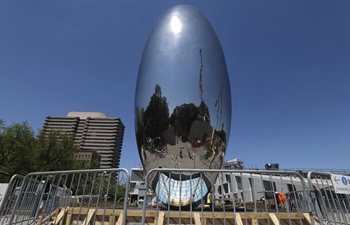WASHINGTON, April 12 (Xinhua) -- A new study published in the journal Science on Thursday reveals that the erosion process of mountains can be a new carbon source.
American researchers reported that mountain erosion can release carbon back into the atmosphere far faster than it is being absorbed into newly-exposed rock.
Scientists previously thought a chemical reaction between minerals on hill slopes and carbon dioxide in the air produced carbonate minerals like calcite, hence capture the carbon.
"This goes against a long-standing hypothesis that more mountains mean more erosion and weathering, which means an added reduction of CO2. It turns out it's much more complicated than that," said Jordon Hemingway, a postdoctoral fellow at Harvard University and lead author on the paper.
The researchers found that the source of this extra CO2 isn't entirely geological. Instead, it is the byproduct of tiny microbes in mountain soils that "eat" ancient sources of organic carbon that are trapped in the rock. As the microbes metabolize these minerals, they spew out carbon dioxide.
They studied the central range of Taiwan in China, one of the most erosion-prone mountain chains in the world. This steep-sided range is pummeled by more than three major typhoons each year, each of which mechanically erode the soil and rock through heavy rains and winds.
Hemingway and his colleagues examined samples of soil, bedrock, and river sediments from the central range, looking for signs of organic carbon in the rock.
"At the very bottom of the soil profile, you have basically unweathered rock. As soon as you hit the base of the soil, layer, though, you see rock that's loose but not yet fully broken down, and at this point the organic carbon present in the bedrock seems to disappear entirely," said Hemingway. At that point in the soil, the team also noticed an increase in lipids that are known to come from bacteria.
But they said the total level of carbon dioxide released by these microbes wasn't severe enough to have any immediate impact on climate change as these processes take place on geologic timescales.
The study can lead to a better understanding of how mountain-based carbon cycles actually work, which could help generate clues to how carbon dioxide has been regulated since Earth itself formed.













